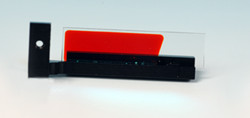Stray Light and second order effects

Stray light is radiation of the wrong wavelength that activates a signal at a detector element. Sources of stray light can be:
Encasing the spectrometer in a light tight housing eliminates ambient stray light.��
�������������
When working at the detection limit of the spectrometer system, the stray light level from the optical bench, grating and focusing mirrors will determine the ultimate limit of detection. Most gratings used are holographic gratings, known for their low level of stray light. Stray light measurements are being carried out with a laser light, shining into the optical bench and measuring light intensity at pixels far away from the laser projected beam. Other methods use a halogen light source and long pass- or band pass filters.
Typical stray light performance is <0.05 % at 600 nm; <0.10 % at 435 nm; <0.10 % at 250 nm.�
Second order effects, which can play an important role for gratings with low groove frequency and therefore a wide wavelength range, are usually caused by the grating 2nd order diffracted beam. The effects of these higher orders can often be ignored, but sometimes need to be taken care of. The strategy is to limit the light to the region of the spectra, where order overlap is not possible.
Second order effects can be filtered out, using a permanently installed long-pass optical filter in the SMA entrance connector or an order sorting coating on a window in front of� the detector. The order sorting coatings on the window typically have one long pass filter (590nm) or 2 long pass filters (350 nm and 590 nm), depending on the type and range of the selected grating.
In Table 6 a wide range of optical filters for installation in the optical bench can be found. The use of following long-pass filters is recommended: OSF-475 for grating NB and NC, OSF-515/550 for grating NB and OSF-600 for grating IB.
In addition to the order sorting coatings we implement partial DUV coatings on Sony 2048 and Toshiba 3648 detectors to avoid second order effects from UV response and to enhance sensitivity and decrease noise in the Visible range.
This partial DUV coating is done automatically for the following grating types:
-
UA for 200-1100 nm, DUV400, only first 400 pixels coated
-
UB for 200-700 nm, DUV800, only first 800 pixels coated
Filters installed in AvaSpec spectrometer series
|
|
Permanently installed 1 mm order sorting filter @ 371 nm
|
|
OSF-475
|
Permanently installed 1 mm order sorting filter @ 466 nm
|
|
OSF-515
|
Permanently installed 1 mm order sorting filter @ 506 nm
|
|
OSF-550
|
Permanently installed 1 mm order sorting filter @ 541 nm
|
|
OSF-600
|
Permanently installed 1 mm order sorting filter @ 591 nm
|
|
OSC
|
Order sorting coating with 590nm long pass filter for� VA, BB (>350nm) and VB gratings in AvaSpec-1024/2048/3648/2048x14
|
|
OSC-UA
|
Order sorting coating with 350 and 590nm long pass filter for UA gratings in AvaSpec-1024/2048/3648/2048x14 �
|
|
OSC-UB
|
Order sorting coating with 350 and 590nm long pass filter for UB or BB (<350nm) gratings in AvaSpec-1024/2048/3648/2048x14
|
|